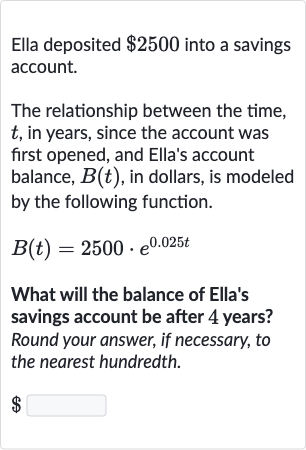AI tutor
Welcome to Bytelearn!
Let’s check out your problem:

Ella deposited into a savings account.The relationship between the time, , in years, since the account was first opened, and Ella's account balance, , in dollars, is modeled by the following function.What will the balance of Ella's savings account be after years? Round your answer, if necessary, to the nearest hundredth.
Full solution
Q. Ella deposited into a savings account.The relationship between the time, , in years, since the account was first opened, and Ella's account balance, , in dollars, is modeled by the following function.What will the balance of Ella's savings account be after years? Round your answer, if necessary, to the nearest hundredth.
- Identify Given Information: Identify the given information and the formula to use.We are given the initial deposit amount (.B(t) = \cdot e^{. \cdot t}$ years.
- Substitute Values into Formula: Substitute the given values into the formula.\(\newline\)We need to substitute \(t = 4\) into the formula to find \(B(4)\), which represents the balance after \(4\) years.\(\newline\)\(B(4) = 2500 \times e^{(0.025 \times 4)}\)
- Calculate Exponent Part: Calculate the exponent part of the formula.\(\newline\)\(0.025 \times 4 = 0.1\)\(\newline\)Now we have \(B(4) = 2500 \times e^{0.1}\)
- Calculate Value of \(e^{0.1}\): Calculate the value of \(e^{0.1}\). Using a calculator, we find that \(e^{0.1} \approx 1.105170918\)
- Multiply Initial Amount: Multiply the initial amount by the calculated exponential factor to find the balance.\(\newline\)\(B(4) = 2500 \times 1.105170918\)\(\newline\)\(B(4) \approx 2762.927295\)
- Round to Nearest Hundredth: Round the result to the nearest hundredth as instructed.\(\newline\)B(\(4\)) \(\approx\) \(\$2762.93\)
More problems from Convert between customary and metric systems
QuestionGet tutor help
QuestionGet tutor help
QuestionGet tutor help
QuestionGet tutor help
QuestionGet tutor help
QuestionGet tutor help
